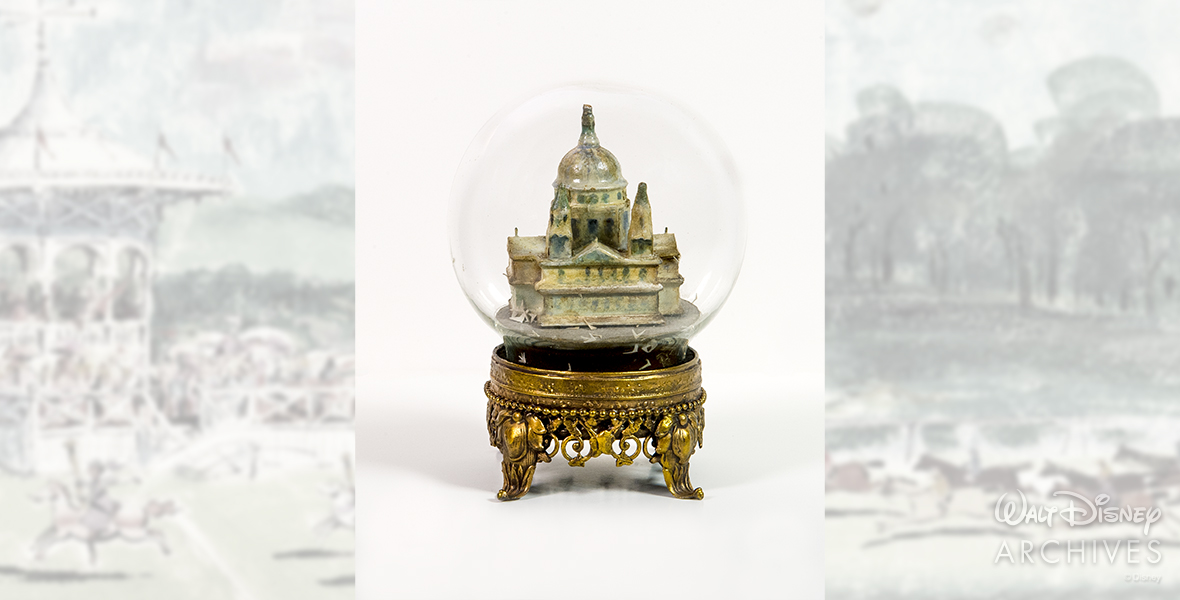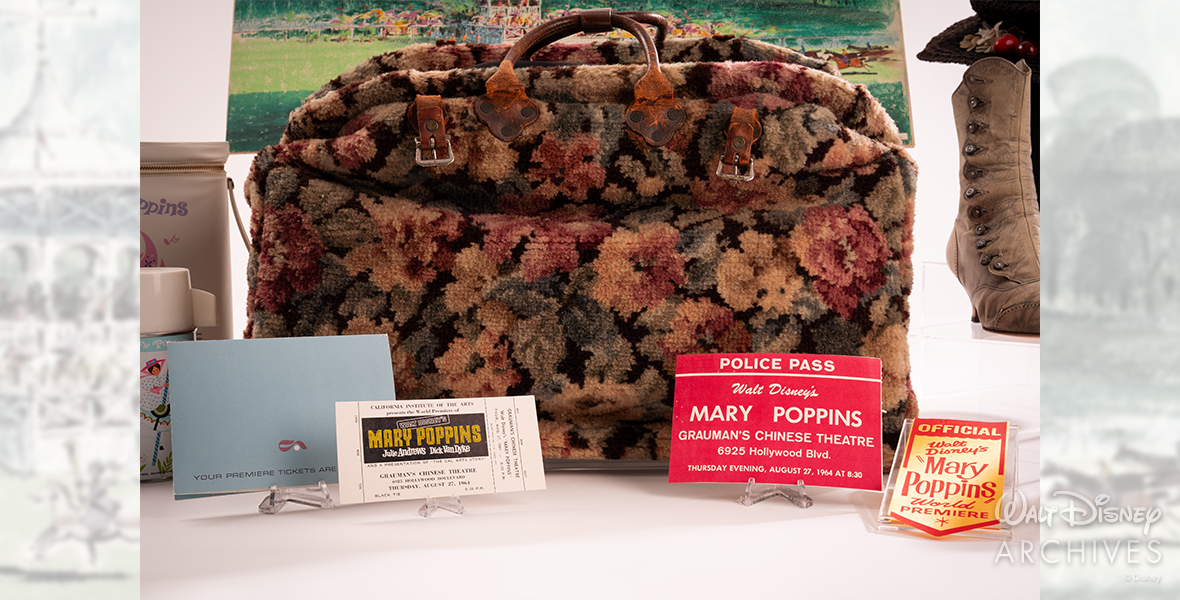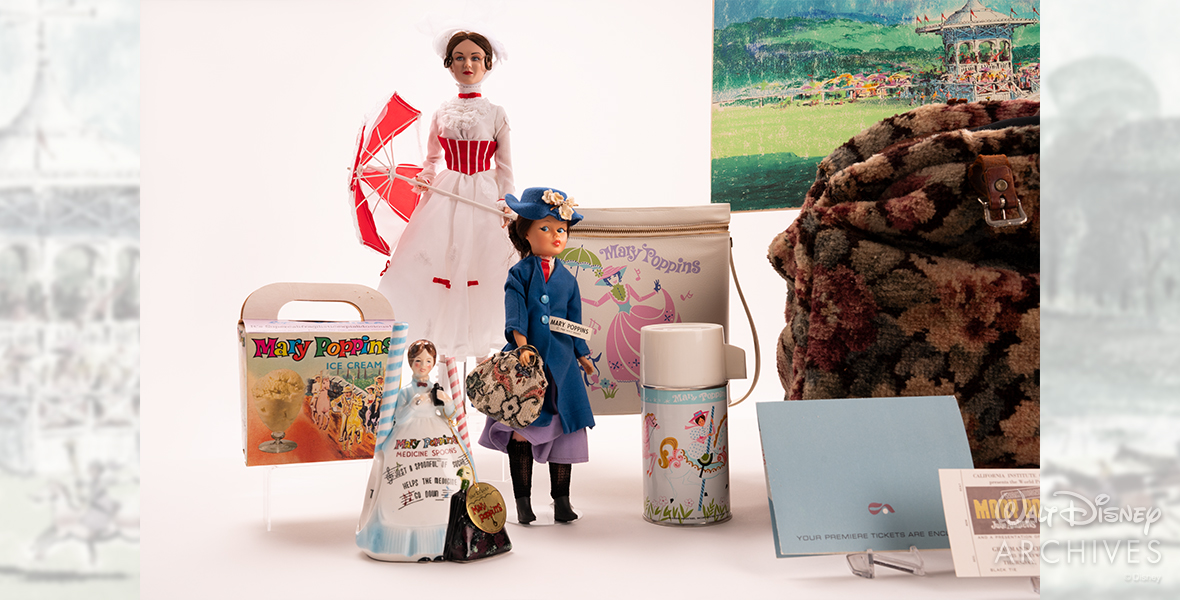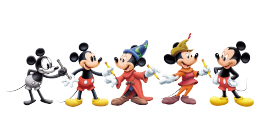By Taylor Larsen, Walt Disney Archives
Sixty years ago, the world was introduced to a cinematic version of Cherry Tree Lane. Nice little spot, you might say. Fit with a “responstable” constable who dutifully watches over the Londoners in the area and Bert, a multitalented musician, screever (pavement artist), and London’s finest chimney sweep. Cherry Tree Lane is also the home of Admiral Boom, who is famous for his punctuality. “The whole world takes its time from Greenwich. But Greenwich, they say, takes its time from Admiral Boom,” as Bert puts it.
Just down a bit lives the Banks family at 17 Cherry Tree Lane. “Heavy weather brewing at number 17, and no mistake.” Heavy weather, until one of literature’s most beloved and delightful heroines, Mary Poppins, at long last stepped from the printed page to become an unforgettable personality through the motion picture magic of master storyteller Walt Disney.
Mary Poppins arrives at Cherry Tree Lane amid great fanfare, blown in by the East Wind. Carrying with her a talking parrot-head umbrella and a magical, bottomless carpet bag full of hidden surprises that delightfully puzzle the Banks children and viewers worldwide. For anyone who has seen the film, a whimsical adventure awaits the residents of 17 Cherry Tree Lane, along with some key life lessons. For instance, “Never judge things by their appearance, even carpet bags.” No wonder that it’s Mary that we love!

On the subject of carpet bags, to celebrate one of the world’s most delightful motion picture spectacles—the release of Mary Poppins, a film that would be critically hailed as one of Walt Disney’s crowning accomplishments and beloved by generations—a collection of iconic props, documents, and artifacts from this musical fantasy is proudly presented here by the Walt Disney Archives. One of these awe-inspiring movie props, the charmingly mysterious carpet bag, is seen above. (Yes, the very bag Disney Legend Julie Andrews used!) Perhaps you remember the first time you saw this film, filled with the same wonder of the Banks children as Mary seamlessly opened her bag and pulled out impossibly large items, including a hat stand, gilt-edged mirror, glossy-leaved plant, and lighted floor lamp. Whether or not you wondered how she pulled off this incredible feat, through magic or special film effects (might as well have been magic, given the film was produced in the early 1960s with very little of today’s technology!), it is still easy to relate to the astonished children, especially Michael Banks who observed after peering inside the bag, “But there was nothing in it!”
I can remember my first time watching Mary Poppins, and all the many rewatches since, and still being mesmerized by that scene, wondering how it was achieved. Having seen the actual bag inside the Walt Disney Archives, I can firmly say just how magical an object it is to behold, and I am thrilled that the prop is in good hands. Of course, I’m not the only member of the Archives staff who feels this way. Darlene Fogg, Senior Secretary with the Archives, remembers going to see Mary Poppins during its 1980 theatrical re-release, commenting that the title character was unlike any character she had ever seen before and that everything “from the scenery to the music, right down to the special magical carpet bag” was perfect. “I am so thrilled that the Walt Disney Archives has the carpet bag in [our] collection,” she continues, “along with other precious pieces from Mary Poppins.”
Eager to see some of these other “precious pieces” Darlene was referencing, I peered inside the bag, just like young Michael, to see if there was anything in it. As it turns out, I found a few surprises and have pulled them out for you to enjoy.

The Walt Disney Archives is a treasure trove of Disney’s rich history. Covering more than a hundred years of storytelling, our collection is a testament to Walt Disney’s enduring legacy. The Archives houses countless of historical objects, each with a unique story, that are carefully preserved in unassuming, secret locations in and around the company’s headquarters in Burbank, California. If our very own Mary Poppins were to fly in for a visit, she might say, “Never judge things by their appearance, even unassuming, secretive warehouses.” In that way, the Archives is like Mary’s mystical bag, which holds treasures of every kind. Over 500 objects related to the 1964 film are safeguarded in the vaults of these locales, and here some are “pulled out of the bag” to represent the film’s production, premiere, merchandising, and legacy.
The production of Mary Poppins was a marvel of creativity and ingenuity. Some of the most lavish sets ever seen in a Walt Disney production were designed and housed across four sound stages on The Walt Disney Studios lot in Burbank, California. The Cherry Tree Lane and nearby park set filled an entire stage and was a testament to the filmmakers’ attention to detail. Every cherry blossom, made of materials imported from France and Portugal, was mounted into place by hand, creating a stunning (and memorable) visual effect. A 360-degree cyclorama was painted to surround the entire set, adding depth and dimension to the lovely London sky. These settings were designed and created by art directors Carroll Clark and William H. Tuntke, with Emile Kuri, two-time Academy Award® winner, and Hal Gausman handling the set decoration. Noted English designer Tony Walton created colorful costumes and was a design consultant for the overall production.
Pictured above are several items from Mary’s wardrobe that Walton and his team designed: Mary’s classic black hat, with bright red cherries and flowers, her “Jolly Holiday” boots, and her arrival shoes. Becky Cline, Director of the Walt Disney Archives, recalls a time in her career when she received frequent phone calls from Disney enthusiasts who inquired how many cherries were on Mary’s hat. (If you’re wondering, the answer is eight.)
Some passionate Poppins experts may notice that Mary’s “Jolly Holiday” boots look a bit different than how they first appeared on screen in the pastel English countryside. These shoes were indeed worn by Disney Legend Julie Andrews but were later painted white and used in the 1968 Disney musical The One and Only, Genuine, Original Family Band, where they were worn by actress Lesley Ann Warren.

Speaking of the pastel English countryside, a team of remarkable studio professionals collaborated to ensure Mary Poppins was a monumental work of artistry. The rich and fantastical animated world they created for the film’s “Jolly Holiday” segment acts as a whimsical break from the characters’ everyday London schedule, offering an inviting, impressionistic journey into one of the sidewalk drawings by Bert (our screever friend played by Disney Legend Dick Van Dyke). This practically perfect production art featuring the iconic horse race sequence is a perfect example of the talent, skill, and imagination of art director Carroll Clark and artists (and Disney Legends) Xavier “X” Atencio, Don DaGradi, Bill Justice, and Peter Ellenshaw. This colorful artwork is among hundreds of concept drawings, exploratory sketches, matte paintings, and other visual art from the production carefully preserved in the Walt Disney Archives.

Here’s a glimpse of one of the most beloved props in the Archives collection, and from a pivotal scene in the film: a moment when Mary teaches the Banks children a precious life lesson as she sings to them the special lullaby “Feed the Birds” (written by Disney Legends Richard M. and Robert B. Sherman). The story of how this snow globe, featuring St. Paul’s Cathedral, found its way to the Archives is remarkable. One day, years after the film’s release, the head janitor at the Disney studio found the object in the trash. Thinking it was interesting, he saved it and displayed the snow globe in his office. In the early 1970s, when a then newly hired Dave Smith (founder of the Walt Disney Archives and a Disney Legend) saw it on the janitor’s shelf, he correctly identified it as the one from the film. The legendary snow globe is currently on display at Disney100: The Exhibition in Kansas City, Missouri.

Mary Poppins famously premiered at Grauman’s Chinese Theatre on Thursday, August 27, 1964—arguably one of the most enlivening nights in Walt Disney’s career. Songwriter and Disney Legend Richard Sherman recalled, “It was one of the most amazing experiences of my life…. After four years of working on this film, I was floating on clouds.” The Archives collection preserves several unique pieces from the historic premiere, including this ticket and envelope (left), an official lapel ribbon worn by premiere staff, and a police pass.
It took seven months to plan for such a lavish and special premiere, and this one would be Walt’s first massive Hollywood event since the groundbreaking Snow White and the Seven Dwarfs in 1937. The evening also served as a benefit for CalArts, a groundbreaking school being developed to train a new generation of artists. Before Walt’s masterwork was unveiled to the invited audience, a 15-minute film, The CalArts Story, narrated by famed actor Sebastian Cabot, was screened.
Then, the opening credits for Mary Poppins rolled for the first time. Richard Sherman recalled, “We were all praying it would be a success. We thought it was good, but maybe we were just [biased]. Everybody was just glued to that screen. They laughed at all the right places. After ‘Step in Time,’ there was thunderous, screaming applause…. [and] when it was over, everybody stood up en masse and applauded. And they continued standing for five minutes. Women were wiping their eyes. [Co-producer and Disney Legend] Bill Walsh leaned over and winked. I looked over at Walt, and he was all smiles. He felt so good. What a wonderful thing for the creators of the film to feel and see.”

In its initial release, Mary Poppins was a genuine box office hit and received 13 Academy Award nominations, including five wins. Mary Poppins fandom continues to soar to the highest heights, and the Archives houses an impressive array of representative merchandise produced from the film’s release through the present. Merchandise played a vital role in the marketing of Mary Poppins the world over, as Disney licensed the film’s characters to a variety of companies for use on a plethora of product. On the heels of the film’s 1964 release, our magical prop carpet bag left the Disney studio as part of a promotional giveaway by Kraft Chocolates. The first prize was the carpet bag filled with $10,000 in cash. The winners apparently valued the money more than the bag, which reportedly sat in an attic for some 40 years before being correctly identified and finding its way to the Walt Disney Archives.
Pictured above are several notable pieces from the Archives’ collection of merchandise. Two Mary Poppins dolls—one more vintage, in a stylish blue jacket with matching hat, and a more recent one sporting her iconic “Jolly Holiday” look—showcase the differences and looks across generations. We’re also pleased to showcase this adorable lunch bag with Thermos® and a ceramic Mary, complete with two measuring spoons. And who wouldn’t want to eat ice cream out of that superb ice cream box?
No other studio could have created a film like Mary Poppins. “Mary Poppins resonated with me because it is simultaneously humorous, innovative, and deeply heartfelt,” says Patrick Letrondo Markulis, a Retouching Specialist with the Walt Disney Archives’ photo digitization team. Patrick and countless other fans have learned from the wisdom Mary imparts on the Banks family, hoping her aphorisms, truths, and life lessons stay with them through adulthood. “In the film, and in life, children see a lot of magic that only some adults see. I grew up hoping I’d be one of those adults,” Patrick adds. What better film can teach us, young or young at heart, that magic can be found anywhere, even in unassuming carpet bags.



